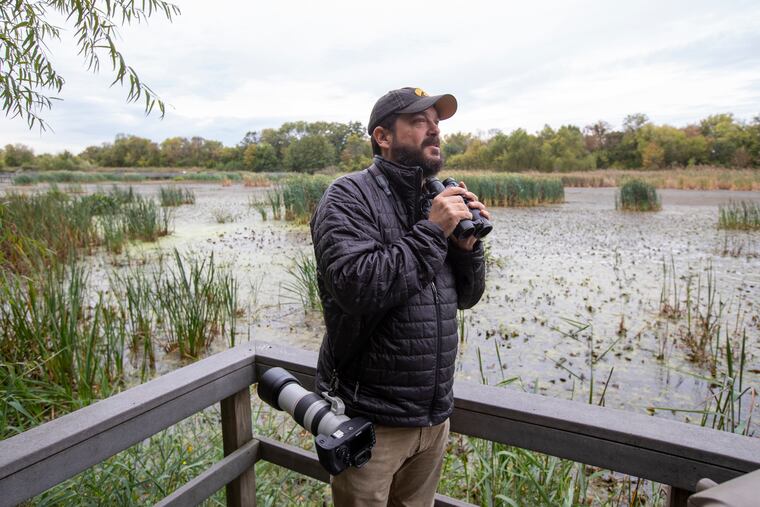Philly’s Heinz Wildlife Refuge opens just to deer hunters, angering birders in prime viewing season
The U.S. Fish and Wildlife Service received no real pushback last year when it proposed opening the John Heinz at Tinicum National Wildlife Refuge to bow hunting for white-tailed deer for the first time in nearly 50 years - until now.

The U.S. Fish and Wildlife Service received no real pushback last year when it proposed opening the John Heinz National Wildlife Refuge at Tinicum to bow hunting for white-tailed deer for the first time in nearly 50 years.
So officials pressed ahead. The hunt is set to start Wednesday on a portion of the 993-acre refuge in Philadelphia and Tinicum Township. It would be the only legal deer hunt on public land within city borders.
But now, the move has ruffled some birders, who discovered that the entire refuge would be closed for eight days: Wednesday through Saturday and Oct. 23 to 26. That means the grounds will be off-limits to all but archers during a prime migratory bird-watching season, and peak fall foliage viewing.
The Heinz refuge offers a key habitat for migrating birds in a dense landscape and is designated as an Important Bird Area by the National Audubon Society. More than 300 species use the grounds as a migratory stopover, and 80 species, including bald eagles and peregrine falcons, have been recorded nesting on the refuge.
So Heinz has become a popular place for birders, most of whom don’t object to the hunt itself. But they do object to having the refuge closed to all but hunters. Birders have posted on Facebook and reached out to their organizations in opposition to the closure.
“The birding community is generally very happy with management at the Heinz refuge,” said George Armistead, president of the Delaware Valley Ornithological Society and a long-time visitor to the refuge. “I just think this event has been pretty poorly planned out. That’s why it’s gotten such a reaction.
“October is one of the best months to be at the refuge,” Armistead said. "And fall is wonderful when the leaves are turning. I always say Heinz is a refuge for all of us.”
Refuge management say they deliberated for years on the plan, but concede tweaks might be needed in the future to accommodate all. The Pennsylvania Game Commission supported the plan.
Officials held two public meetings on the plan and sought public comment last year, but only recently received pushback, because firm closure dates hadn’t been posted and many birders assumed the hunting would take place in the winter.
Heinz draws 106,000 visitors a year. Most of those are bird watchers, hikers, other wildlife observers, and photographers, who roam 10 miles of trails. Families and schoolchildren also visit the refuge, bordered on the south by I-95. Canoers and kayakers paddle around Darby Creek and Tinicum Marsh.
Deer hunting at the refuge was banned in 1972, when it was established as Tinicum National Environmental Center. It became one of the few refuges in the nation that did not allow hunting. The refuge was renamed in 1991 for U.S. Sen. John Heinz, who died in a plane crash. As a result of the ban, the deer population has climbed.
Wildlife officials say the hunt is necessary because the deer population far exceeds a healthy 29 animals per square mile. That has led to forest damage as deer prevent oak and maple saplings from growing. Invasive species are now the dominant vegetation on the refuge.
Normally, sharpshooters are used to cull the deer. But officials won’t hold hunts with firearms because of the refuge’s location on the outskirts of Philadelphia International Airport. The plan, which officials began crafting in 2012, sought to balance the safety of the general public with hunters’ needs. Officials started with an on-site archery program to help train potential hunters.
The plan called for establishing 167 acres of upland hunting grounds in three sections of the property, in an effort to thin the deer population. One 63-acre parcel is within Philadelphia’s borders near the city’s Eastwick section. The remaining 104 acres are in Tinicum Township. Both are adjacent to Darby Creek.
Lamar Gore, manager of the refuge, said hunters had long asked to use the grounds and considering the deer problem, officials couldn’t justify a continued ban.
“We’ve spent a long time working on this project,” Gore said. “And we looked for the best possible time for archery season to hold the hunt.
“Then people looked at the dates and there was some concern,” Gore said. “I get it. I’m a birdwatcher too.”
He said that the entire refuge would be closed out of an abundance of caution, because it is the first hunt in decades and officials want to gauge how it goes. Overall, the refuge is small compared with others nationally and trails cross each other.
He said he’s sure adjustments will be made for future hunts.
Gore said 38 hunters signed up almost immediately, but he was not certain how many would show. Officials will allow only 12 hunters on the grounds at any time, and they’ll be using stationary, predetermined blinds. One of the goals was to bring new people into hunting and educate them on safety. A mentor program also was setup for hunters ages 12 and over with little to no experience.
Gore noted that all the hunters are licensed in Pennsylvania and that the fees they pay are a key source of conservation funds.
“But,” as one birder posted on the refuge’s Facebook page, “eight full days of closure at peak fall migration season is excessive in my view.”